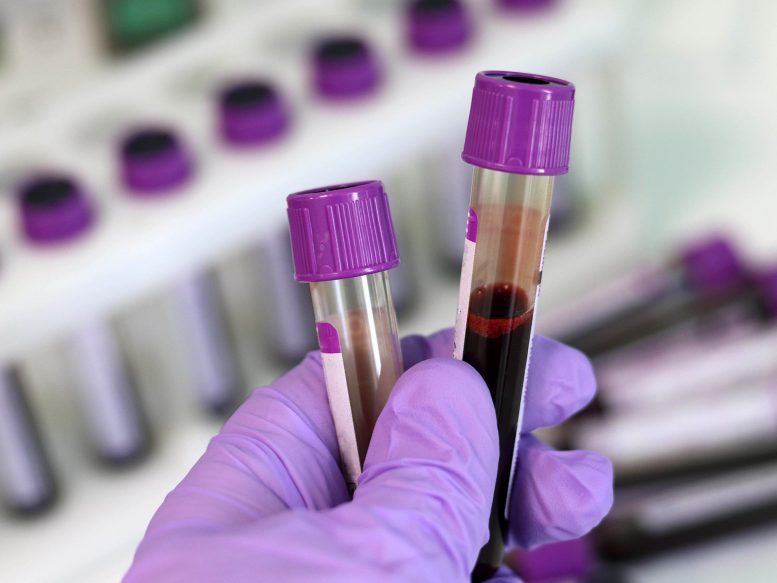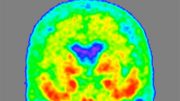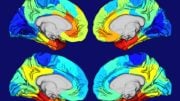
Scientists presented findings at the Alzheimer’s Association International Conference® (AAIC®) 2020 regarding blood tests for abnormal tau protein.
A simple blood test for Alzheimer’s would be a great advance for individuals with — and at risk for — the disease, families, doctors, and researchers.
At the Alzheimer’s Association International Conference® (AAIC®) 2020, scientists reported results of multiple studies on advances in blood “tests” for abnormal versions of the tau protein, one of which may be able to detect changes in the brain 20 years before dementia symptoms occur. In particular, the reports focus on a specific form of tau known as p-tau217, which seems to be the most specific to Alzheimer’s and the earliest to show measurable changes.
Changes in brain proteins amyloid and tau, and their formation into clumps known as plaques and tangles, respectively, are defining physical features of Alzheimer’s disease in the brain. Buildup of tau tangles is thought to correlate closely with cognitive decline. In these newly reported results, blood/plasma levels of p-tau 217, one of the forms of tau found in tangles, also seem to correlate closely with buildup of amyloid.
Currently, the brain changes that occur before Alzheimer’s dementia symptoms appear can only be reliably assessed by positron-emission tomography (PET) scans, and from measuring amyloid and tau proteins in spinal fluid (CSF). These methods are expensive and invasive. And, too often, they are unavailable because they are not covered by insurance, or difficult to access, or both.
“There is an urgent need for simple, inexpensive, non-invasive, and easily available diagnostic tools for Alzheimer’s. New testing technologies could also support drug development in many ways. For example, by helping identify the right people for clinical trials, and by tracking the impact of therapies being tested,” said Maria C. Carrillo, Ph.D., Alzheimer’s Association chief science officer. “The possibility of early detection and being able to intervene with a treatment before significant damage to the brain from Alzheimer’s disease would be game-changing for individuals, families, and our healthcare system.”
A blood test, for example, will enable interpretation and understanding of Alzheimer’s progression in much larger, more diverse, and more robust populations.
“While these new reports are encouraging, these are early results, and we do not yet know how long it will be until these tests are available for clinical use. They need to be tested in long-term, large-scale studies, such as Alzheimer’s clinical trials,” Carrillo added. “In addition, we need to continue research to refine and verify the tests that are the current state-of-the-art — including cerebrospinal fluid and PET imaging biomarkers.”
Blood P-tau217 Detects Alzheimer’s Disease (i.e., Both Plaques and Tangles) with High Accuracy
As reported at AAIC 2020, an international team of researchers have identified a highly accurate, blood-based biomarker for the detection of Alzheimer’s disease by measuring levels of p-tau217 in blood, and validated the finding in multiple, diverse populations. The scientists found that “the diagnostic precision of blood p-tau217 was as high as established diagnostic methods, including positron emission tomography (PET) imaging and cerebrospinal fluid biomarkers, which are invasive, costly, and less available.”
The research team was led by Oskar Hansson, M.D., Ph.D., from Lund University, Sweden in coordination with Sebastian Palmqvist, M.D., Ph.D., and Shorena Janelidze, Ph.D. from Lund, Eric Reiman, M.D., from Banner Alzheimer’s Institute, USA, Jeffrey Dage, Ph.D., from Eli Lilly, USA, and other research colleagues. The Lund University researchers presented the results at AAIC, and they were also published online.
They studied three different cohorts comprising more than 1,400 cases, including a large clinic-based study from Sweden (the BioFINDER-2 study), a cohort with neuropathological confirmation of Alzheimer’s (the Arizona Study of Aging and Neurodegenerative Disorders), and a large kindred with genetically-caused Alzheimer’s (Colombian autosomal-dominant Alzheimer’s registry).
They analyzed other current experimental biomarkers (p-tau217, p-tau181, Aβ42/40, and neurofilament light chain) in both blood and cerebrospinal fluid, as well as performed PET imaging for tau and amyloid pathology.
The main finding of the study was that blood p-tau217 could distinguish Alzheimer’s from other neurodegenerative disorders with diagnostic accuracy between 89 and 98 percent. In this study, the p-tau271 assessment was more accurate for Alzheimer’s than blood-based tests for p-tau181, neurofilament light or amyloid beta 42/40 ratio, as well as magnetic resonance imaging (MRI). In fact, according to the researchers, performance was similar to significantly more costly methods, such as PET imaging and cerebrospinal fluid biomarkers.
The researchers also found that p-tau217 analyzed in blood collected during life could detect tau brain changes measured in brain tissue analyzed after death. These tau brain changes are thought to be related to amyloid plaque accumulation. P-tau217 distinguished persons who had plaques and tangles from those without Alzheimer’s pathology with 89% accuracy, those with plaques and more extensive tangles with 98% accuracy, and the outcome of tau PET imaging with 93% accuracy.
The p-tau217 levels were increased about seven-fold in Alzheimer’s, and, in individuals with a gene causing Alzheimer’s, the levels started to increase already 20 years before onset of cognitive impairment. “This test, once verified and confirmed, opens the possibility of early diagnosis of Alzheimer’s before the dementia stage, which is very important for clinical trials evaluating novel therapies that might stop or slow down the disease process,” Hansson said.
Blood Amyloid and P-tau are Precise Markers of Brain Amyloidosis, Tauopathy
To advance research on a blood test for Alzheimer’s disease, Suzanne Schindler, M.D., Ph.D., of Washington University School of Medicine in St. Louis and colleagues evaluated the performance of a variety of amyloid and tau measures in blood.
Using mass spectrometry, the scientists mapped the blood plasma tau protein and compared the results to CSF and PET imaging measures. Compared to the better-known tau form p-tau181, they found that p-tau217 was more closely linked to build up of amyloid plaques in the brain as measured by a PET scan.
Additionally, their findings suggest that measuring levels of several different forms of p-tau in blood over time may enable clinicians and researchers to track the stages of Alzheimer’s progression in people living with the disease.
According to the researchers, a blood test for Alzheimer’s disease that incorporates both amyloid and tau measures may allow earlier and more accurate dementia diagnoses not only in research participants but also in clinic patients.
The scientists launched the Study to Evaluate Amyloid in Blood and Imaging Related to Dementia (SEABIRD) to develop and validate Alzheimer’s blood biomarkers in a cohort that is more diverse and representative of the greater St. Louis region. SEABIRD will enroll more than 1,100 individuals including diversity in race, socioeconomic status, medical history and cognitive status.
Plasma P-tau217 is Comparable to P-tau181 for Distinguishing Between Alzheimer’s and Frontotemporal Lobar Degeneration
Recent studies have shown that p-tau181 is more than three times as high in people with Alzheimer’s compared to healthy elderly people or people with a neurodegenerative disease known as frontotemporal lobar degeneration (FTLD). At AAIC 2020, Elisabeth Thijssen, M.Sc., and Adam L. Boxer, M.D., Ph.D., of the UCSF Memory and Aging Center and colleagues reported a comparison of p-tau181 to a related form of tau called p-tau217 to determine which form can best identify people with Alzheimer’s.
The retrospective study included 617 participants: 119 healthy controls, 74 Alzheimer’s cases (biomarker-confirmed) and 294 FTLD. In this study group, plasma p-tau181 was increased three-fold in people with Alzheimer’s compared to controls and FTLD. Increase in plasma p-tau217 was even higher; five-fold in Alzheimer’s compared to healthy controls and four-fold relative to FTLD. The plasma comparison results mirrored the findings of tau PET imaging in the brain. P-tau181 had a 91% accuracy and p-tau217 had a 96% accuracy in predicting whether a person had a tau-positive brain scan.
According to the researchers, the study shows that both p-tau217 and p-tau181 measured in blood are elevated in Alzheimer’s, and that measurements closely correspond to “gold standard” PET scan results. These blood tests are likely to be useful for diagnosing Alzheimer’s and as monitoring tools in clinical trials to measure the treatment effects of new Alzheimer’s therapies.









Are there more studies ongoing? in Georgia; if so, contact info?
I’m about to turn 69. My dad died at 88 w/Alzheimer’s; my mom will soon turn 96 w/o Alzheimer’s. Wondering if that history might “fit” into a study.
Im wondering if this isn’t going to come down to levels of OXYGEN over time, and too much CO2 over time.
https://www.sciencedirect.com/science/article/pii/S0160412018312807
Closing neighborhood schools and opening 1,000 student body mega schools has been highly detrimental for our children’s health.
Whether or not school open in the fall, this entire concept of ‘social distancing’ is giving more oxygenated air and reducing the CO2 saturated air around each child. Elites who have hired au pairs for their home and private school students will be the healthiest. Less cars in the roads, less planes in the air, less draw on the power grid equal healthier children and old folks. Let’s walk everywhere, fish from a row boat, bike to grandma’s and mow her grass.